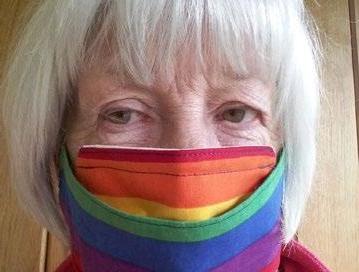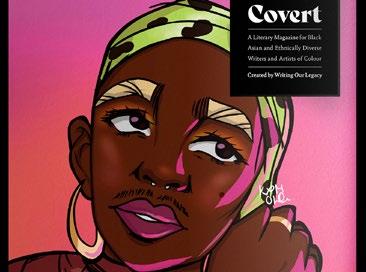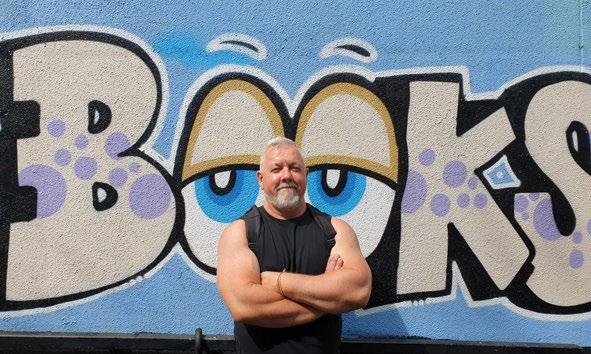
10 minute read
Covert magazine
FREE TO BE ME

Advertisement
) While admitting that her new book, Free To Be Me: Refugee Stories from the Lesbian Immigration Support Group (LISG), is “not an easy read”, Jane Traies hopes this selection of lesbian life stories by women who have been part of the LISG in Manchester will be read as being “about courage, being yourself, the kindness of strangers”. Jane’s journey into this book began three years ago when she received an email from a volunteer with the group who had heard of the work she had done with older lesbians and wondered if she might have anything in her research that could help a refugee from Uganda. The woman, in her 70s, had been fighting for asylum for 13 years but been turned down because the Home Office didn’t believe she was a lesbian. Jane met with the group and helped prepare a statement. Eventually the woman was granted asylum. “She and I were born in the same year and I kept thinking about her life and mine and I don’t think I’ve ever been so aware of my own privilege.” Jane wanted to tell the stories and was able to carry out most of the interviews face to face in Manchester “literally days before lockdown”. Jane says: “Some of the experiences of the women who have to leave their country were horrific and do include sexual violence. It’s not an easy read but I hope it’s worthwhile.” “My mum called me and cried on the phone, saying I’d brought shame to the family. My father said he never wanted to set his eyes on me again and that the day he does, he will kill me.” (Faith) All proceeds from the book, to be published by Tollington Press on International Women’s Day, Monday, March 8, are going to go back to the LISG, “so I have no shame in saying ‘buy my book’”. It wasn’t the easiest of projects to put together, as Jane explains: “If you’re seeking asylum and have had your claim rejected by the Home Office they take away your support, so most of the women have no income and nowhere to live; no computers, only a phone, and no money to use the phone. We do take all those things for granted.” There were also language barriers, so there was toing and froing to ensure everyone was able to say what they wanted to say, but, despite those hurdles and the restrictions of various lockdowns, all the stories were finally signed off and can now be told. “The ways are different here, and at first it was too odd. In the winter, it is so, so cold! But I think I’m better off, far from my own country. Because even if things are so hard, I’m not being beaten, I’m open, I’m free. Nobody says anything like, ‘Why are you wearing clothes like a man?’“ (Sophie) “It’s been a journey,” says Jane. “This is only one small corner of the refugee world. I knew nothing about this three years ago and now I know there are groups all over the UK. All these people have had horrible experiences here because of the culture of disbelief.” ) Earlier this year a very sexy-looking 92-page literary magazine called Covert was released to showcase the creativity of black, Asian and ethnically diverse writers and artists. Produced by Writing Our Legacy in association with New Writing South, the magazine’s theme was: Sussex Fortune Teller – What Do Writers See in the Future, and its impact in terms of both contributors and audience wasn’t necessarily something the editorial team could have predicted. “I think I blew people’s minds a little bit. I decided to really push the boat out [...] .It’s nice to have something a bit special, especially for readers of colour when they don’t have much validation.”
AMY ZAMARRIPA SOLIS “We had more than 100 submissions in each of the categories: fiction, poetry, artwork,” says editorial team member and a driving force behind the project, Amy Zamarripa Solis. “In 2019 we published an anthology of writers of colour called Hidden Sussex, which was life stories, but this book [focusing on fiction and poetry] was something I had been thinking about for six years. “I could observe that there were a lot of talented writers but they might not try to access opportunities or try to get published, so I thought if there was something local [that might sway them]. “A lot of the work we do with people of colour is really about confidence building. We try to do things that still help with that and being published is a great feeling. It really gave me a taste of what community publishing could achieve.” As with so many projects, it was somewhat hampered by the pandemic and the first lockdown, but the group applied for emergency funding from the Arts Council and from March to May was busy organising “lots of solidarity Zoom calls to try to help people stay connected”. Amy and her fellow voluntary editorial team members, writer Sharon Duggal and poet John Prebble, made the initial selection of works and gave recommendations to guest editors for their consideration. Each submission had to fit the theme, which, says Amy, was about asking writers to look into the future. Fifteen contributors are showcased in the magazine. As for the final article, with its high-quality finish: “I think I blew people’s minds a little bit. I decided to really push the boat out. I was originally thinking of doing something digital but with lockdown it’s nice to have something a bit special, especially for readers of colour when they don’t have much validation.”
And the work doesn’t stop there. “The next phase will be approaching universities and libraries to get it to a wider audience,” says Amy. “We haven’t put it on Amazon but we do have an e-book.” Writing Our Legacy has managed to secure further Arts Council funding and is in the process of moving to become a Charitable Incorporated Organisation, along with planning how the next edition will be funded. D For more info, visit: www.writingourlegacy.org.uk
Book Reviews by Eric Page

) Justin David The Pharmacist (£8.99, published by Inkandescent). What a prodigious, heaving, sweaty, sexy book this is, based around the utterly compelling relationship between Billy, a young man drawn into the sphere of Polari speaking, and strikingly debonair Albert, The Pharmacist, a compelling and damaged older drug dealer. Set deep in east London, they first meet in Columbia Road Flower Market, pre-gentrification and drowning in drugs and sex – this is Harold & Maude meets Aldous Huxley. The narrative swirls, dips, rages and explodes across a landscape of enlightenment and change and author David’s prose manages to capture the throbbing urgency of the chemical indulgences deeply entwined with the passion of these two men. This isn’t chemsex, this is a new electrically sensual drug exploding across London. The dialogue is electric and funny, although the humour is often dark, twisted and uncomfortable, perfectly queer. David captures the crepuscular geography of Shoreditch with a loving grace, takes in The Royal Oak pub, filled with seriously diverse queer patrons, noting sunshine brickwork and the dust of generations of Londoners. This is a story of real contact, and physical presence, these men meet, touch, live, share space – physical space – and being visible is urgent and necessary. As Billy learns more of his much older lover’s life the focus of this short book changes, as the ecstasy thumps through his body he begins to understand how accumulated loss can define you. By parts astonishingly tender and brutally honest, The Pharmacist should be on every gay man’s reading list. It’s a seriously impressive book, which pulls you deliriously down into drugged up sensual exploration and fucks you senseless. It also reminds us of what we’ve lost, and that’s a sadness worth reflecting on. Recommended.
) Adam MacQueen Beneath the Streets (£8.99, published by Lightning Books). ‘What if Jeremy Thorpe had succeeded in murdering Norman Scott?’. MacQueen’s first novel gives us an alternative history based around corrupt 1970s England and the dark London underbelly of sex for sale and political intrigue. Set in 1976, the naked corpse of a young rent boy is fished out of a pond on Hampstead Heath. Since the police don’t seem to care, 20-yearold Tommy – himself a former rent boy – finds himself investigating. Dodging murderous Soho hoodlums and the agents of a more sinister power, Tommy follows the trail of guilt higher still. The ruthless Establishment will stop at nothing to cover its tracks. The narrator is darkly funny, the streets as grubby as you’d imagine and the insights into gay life in this shadowy pre-AIDS world of queer Soho and its endless opportunities for ‘cottaging’ are wonderfully evocative. With a cast of real-life characters from The Sex Pistols, Prime Minister Harold Wilson to adviser Lady Falkender, this is a well-balanced thriller which keeps the pages turning until the rather sharp, surprising sting in its closing chapter. ) Niven Govinden Diary of a Film (£14.99, published by Dialogue Books). This perfectly poised story about cinema, flâneurs and queer love takes us into the world of the ‘maestro’ -
auteur and creative. Clocking the toil, keeping control of the stories you harvest, create and define you can take on the teller. We follow our ‘maestro’ and his lead actors as they flounce around a European festival at the premiere of his latest film. By chance he meets a woman who invites him to explore her world, her story, her perspective and as her powerful narrative captures his attention, they walk the streets together. This gentle stroll contains an urgent story of love, loss and responsibility that the ‘maestro’ wants to own, any way he can. That’s it, the plot. The book is written with no quotation marks, paragraphs or the usual signallers to assist a reader, so the book itself is an observation of the creative process. It’s an oddly distanced book, with some oddly distanced queer love, which took some time to get into, but when it unfolded itself into a study of the creative process it hit its stride. Govinden’s careful eye keeps the story interesting, and his prose is rich in descriptive details. It’s meditative in the way it roams, both through our slightly arrogant narrator’s thought processes and the city he stalks through. ) Meg Barker & Jules Scheele
Sexuality A Graphic Guide
(£13.99, published by Icon Books). This book impressed on every level, historically it gives a pretty good introduction from earliest societies’ attitudes and practices, then sweeps across various global societies giving insight and learning from different epochs, cultures and highlighting social changes and who and what made them happen. The fun and informative monochrome illustrations on every page bring lighthearted insight to the topics being discussed. The illustrations immediately let you know what’s being debated here and help to highlight intersectional aspects for contemplation. Scheele’s deft comic touch shines a light into the darkness of shame, fear and frustrations. The book looks at lots of up-to-date concerns, examining their roots in prejudice, bigotry or intolerance and looks at ways of integrating previous taboo subjects into everyday healthy practice. This guide is fun, educational and makes you think, it presents as an easy to understand graphic guide to sexuality, which it certainly is, but it’s also rather more reflective than that. As the book gathers pace, and leads on from previous chapters, Barker’s solid historical understanding gives us insight into the monsters and pitfalls that hang in the glooms of sexuality but there is a solid narrative drive about acceptance of the infinite diversity of human sexualities and sex and how embracing, understanding and enjoying them is the healthiest approach for a culture or society to take. Barker and Scheele combine their talents again to serve this entertaining book about sexuality which manages to tease gently along the balance between being erotic and historically informative. Superb.











